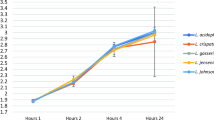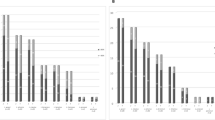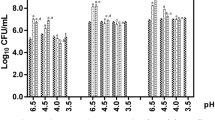Abstract
Lactobacilli strains are considered as a preventive means for treatment of vaginal infections or post-antibiotic treatment to repopulate the vaginal mucosa. This study aimed at establishing the vaginal lactobacillus profile of Algerian women with different vaginal diseases. Afterwards, lactobacilli isolated from swabs were in vitro characterized for their probiotic hallmarks. This prospective study allowed isolation of 44 Lactobacillus strains and 160 potentially pathogens, among which are Escherichia coli (50 isolates), Staphylococcus sp. (38 isolates), Enterococcus sp. (16 isolates), and Candida sp. (56 isolates). All Lactobacilli strains were characterized for their antagonism, adhesion to polystyrene, and resistance to acidity and bile. Consequently, six Lactobacillus strains (Lb. fermentum 5LB4, 5LB10, 5LB12, Lb. plantarum 5LB2, 5LB11, and Lactobacillus sp. 4LB9) were moderately or weakly adherent, and 35 potentially pathogens exhibited weak to strong adhesion to polystyrene. Antagonism was recorded for 36 Lactobacillus strains towards E. coli 6E2, S. aureus 7S3, Enterococcus sp. 5EN8, and Candida albicans C1 used as indicator organisms. Finally, Lb. fermentum 9LB6, 4LB16, and 10LB1 and Lb. plantarum 9LB4 were remarkable for their inhibitory activity, absence of hemolytic potential, and for their resistance to acidity (pH 1.5) and bile (0.5%) harsh conditions.






Similar content being viewed by others
References
Petricevic L, Domig K, Nierscher F, Sandhofer M, Fidesser M, Kro-ndorfer I, Husslein P, Kneifel W, Kiss H (2014) Characterisation of the vaginal Lactobacillus microbiota associated with preterm delivery. Sci Rep 4(1):5136. https://doi.org/10.1038/srep05136
Al Kassaa I, Hamze M, Hober D, Chihib NE, Drider D (2014) Identification of vaginal lactobacilli with potential probiotic properties isolated from women in North Lebanon. Microb Ecol 67(3):722–734. https://doi.org/10.1007/s00248-014-0384-7
Kamińska D, Gajecka M (2017) Is the role of human female reproductive tract microbiota underestimated? Benefic Microbes 8(3):327–343. https://doi.org/10.3920/BM2015.0174
Witkin SS, Linhares IM (2017) Why do lactobacilli dominate the human vaginal microbiota? BJOG 124(4):606–611. https://doi.org/10.1111/1471-0528.14390
Zhou X, Brown CJ, Abdo Z, Davis CC, Hansmann MA, Joyce P, Foster JA, Forney LJ (2007) Differences in the composition of vaginal microbial communities found in healthy Caucasian and black women. ISME J 1(2):121–133. https://doi.org/10.1038/ismej.2007.12
Ravel J, Gajer P, Abdo Z, Schneider GM, Koenig SS, McCulle SL, Karlebach S, Gorle R, Russell J, Tacket CO, Brotman RM, Davis CC, Ault K, Peralta L, Forney LJ (2011) Vaginal microbiome of reproductive-age women. Proc Natl Acad Sci U S A 108(Supplement_1):4680–4687. https://doi.org/10.1073/pnas.1002611107
Lepargneur JP (2016) Lactobacillus crispatus as biomarker of the healthy vaginal tract. Ann Biol Clin 74:421–427
Petrova MI, Reid G, Vaneechoutte M, Lebeer S (2017) Lactobacillus iners: friend or foe? Trends Microbiol 25(3):182–191. https://doi.org/10.1016/j.tim.2016.11.007
Le Blanc R-M (2009) Détecter des infections génitales basses chez la femme. Option Biologie 424:19–20
Miller EA, Beasley DE, Dunn RR, Archie EA (2016) Lactobacilli dominance and vaginal pH: why is the human vaginal microbiome unique? Front Microbiol 7:1936. https://doi.org/10.3389/fmicb.2016.01936
Tachedjian G, Aldunate M, Bradshaw CS, Cone RA (2017) The role of lactic acid production by probiotic Lactobacillus species in vaginal health. Res Microbiol. https://doi.org/10.1016/j.resmic.2017.04.001
FAO/WHO (2006) Probiotics in food. Health and nutritional properties and guidelines for evaluation. FAO Food and Nutritional paper No. 85
Newman D (1915) The treatment of cystitis by intravesical injections of lactic bacillus cultures. Lancet 186(4798):330–332. https://doi.org/10.1016/S0140-6736(01)53633-8
van de Wijgert JH, Borgdorff H, Verhelst R, Crucitti T, Francis S, Verstraelen H, Jespers V (2014) The vaginal microbiota: what have we learned after a decade of molecular characterization? PLoS One 9(8):e105998. https://doi.org/10.1371/journal.pone.0105998
Onderdonk AB, Delaney ML, Fichorova N (2016) The human microbiome during bacterial vaginosis. Clin Microbiol Rev 29(2):223–238. https://doi.org/10.1128/CMR.00075-15
Daliri EBM, Lee BH (2015) New perspectives on probiotics in health and disease. Food Sci Human Wellness 4(2):56–65. https://doi.org/10.1016/j.fshw.2015.06.002
Donders GG, Zodzika J, Rezeberga D (2014) Treatment of bacterial vaginosis: what we have and what we miss. Expert Opin Pharmacother 15(5):645–657. https://doi.org/10.1517/14656566.2014.881800
Petrina MAB, Cosentino LA, Rabe LK, Hillier SL (2017) Susceptibility of bacterial vaginosis (BV)-associated bacteria to secnidazole compared to metronidazole, tinidazole and clindamycin. Anaerobe 47:115–119. https://doi.org/10.1016/j.anaerobe.2017.05.005
Vasquez A, Ahrne S, Jeppsson B, Molin G (2005) Oral administration of Lactobacillus and Bifidobacterium strains of intestinal and vaginal origin to healthy human females: re-isolation from faeces and vagina. Microb Ecol Health Dis 17(1):15–20. https://doi.org/10.1080/08910600510031376
Guiraud JP (2003) Microbiologie alimentaire. Dunod, Paris
Kos B, Šušković J, Vuković S, Šimpraga M, Frece J, Matošić S (2003) Adhesion and aggregation ability of probiotic strain Lactobacillus acidophilus M92. J Appl Microbiol 94(6):981–987. https://doi.org/10.1046/j.1365-2672.2003.01915.x
Rosenberg M, Gutnick D, Rosenberg E (1980) Adherence of bacteria to hydrocarbons: a simple method for measuring cell-surface hydrophobicity. FEMS Microbiol Lett 9(1):29–33. https://doi.org/10.1111/j.1574-6968.1980.tb05599.x
O’Toole G, Kolter R (1998) Flagellar and twitching motility are necessary for Pseudomonas aeruginosa biofilm development. Mol Microbiol 30(2):295–304. https://doi.org/10.1046/j.1365-2958.1998.01062.x
Ait Ouali F, Al Kassaa I, Cudennec B, Abdallah M, Bendali F, Sadoun D, Chihib NE, Drider D (2014) Identification of lactobacilli with inhibitory effect on biofilm formation by pathogenic bacteria on stainless steel surfaces. Int J Food Microbiol 191:116–124. https://doi.org/10.1016/j.ijfoodmicro.2014.09.011
Comité de l’Antibiogramme de la Société Française de Microbiologie (CFA-SFM). Recommandations 2015. Paris, France. Société Française de Microbiologie
Bendali F, Durand A, Hébraud M, Sadoun D (2011) Lactobacillus paracasei subsp. paracasei: an Algerian isolate with antibacterial activity against enteric pathogens and probiotic fitness. J Food Nutr Res 50:139–149
Stepanovic S, Vukovic D, Dakic I, Savic B, Svabic-Vlahovic M (2000) A modified microtiter-plate test for quantification of staphylococcal biofilm formation. J Microbiol Methods 40(2):175–179. https://doi.org/10.1016/S0167-7012(00)00122-6
Nunn KL, Forney LJ (2016) Unraveling the dynamics of the human vaginal microbiome. Yale J Biol Med 89(3):331–337
Kaewnopparat S, Dangmanee N, Kaewnopparat N, Srichana T, Chulasiri M, Settharaksa S (2013) In vitro probiotic properties of Lactobacillus fermentum SK5 isolated from vagina of a healthy woman. Anaerobe 22:6–13. https://doi.org/10.1016/j.anaerobe.2013.04.009
Sabia C, Anacarso I, Bergonzini A, Gargiulo R, Sarti M, Condò C, Messi P, de Niederhausern S, Iseppi R, Bondi M (2014) Detection and partial characterization of a bacteriocin-like substance produced by Lactobacillus fermentum CS57 isolated from human vaginal secretions. Anaerobe 26:41–45. https://doi.org/10.1016/j.anaerobe.2014.01.004
Baldwin EA, Walther-Antonio M, MacLean AM, Gohl DM, Beckman KB, Chen J, White B, Creedon DJ, Chia N (2015) Persistent microbial dysbiosis in preterm premature rupture of membranes from onset until delivery. Peer J 3:e1398. https://doi.org/10.7717/peerj.1398
Park TC, Lee HJ (2013) Pregnancy coexisting with uterus didelphys with a blind hemivagina complicated by pyocolpos due to Pediococcus infection: a case report and review of the published reports. J Obstet Gynaecol Res 39(7):1276–1279. https://doi.org/10.1111/jog.12049
Borges S, Barbosa J, Silva J, Teixeira P (2013) Evaluation of characteristics of Pediococcus spp. to be used as a vaginal probiotics. J Appl Microbiol 115(2):527–538. https://doi.org/10.1111/jam.12232
Borges S, Costa P, Silva J, Teixeira P (2013) Effects of processing and storage on Pediococcus pentosaceus SB83 in vaginal formulations: lyophilized powder and tablets. Biomed Res Int 680767
Borges S, Teixeira P (2014) Pediococcus pentosaceus SB83 as a potential probiotic incorporated in a liquid system for vaginal delivery. Benefic Microbes 5(4):421–426. https://doi.org/10.3920/BM2013.0084
Vicariotto F, Mogna L, Del Piano M (2014) Effectiveness of the two microorganisms Lactobacillus fermentum LF15 and Lactobacillus plantarum LP01, formulated in slow-release vaginal tablets, in women affected by bacterial vaginosis: a pilot study. J Clin Gastroenterol 48:106–112
Martin R, Soberon N, Vaneechoutte M, Florez A, Vazquez F, Suarez J (2008) Characterizaton of indigenous vaginal lactobacilli from healthy women as probiotic candidates. Int Microbiol 11(4):261–266. https://doi.org/10.2436/20.1501.01.70
Strus M, Kucharska A, Kukla G, Wloch M, Maresz K, Heczko P (2005) The in vitro activity of vaginal Lactobacillus with probiotic properties against Candida. Infect Dis Obstet Gynecol 13(2):69–75. https://doi.org/10.1080/10647440400028136
Hardy L, Cerca N, Jespers V, Vaneechoutte M, Crucitti T (2017) Bacterial biofilms in the vagina. Res Microbiol. https://doi.org/10.1016/j.resmic.2017.02.001
Leccese Terraf MC, Juarez Tomás MS, Rault L, Le Loir Y, Even S, Nader-Macías ME (2017) In vitro effect of vaginal lactobacilli on the growth and adhesion abilities of uropathogenic Escherichia coli. Arch Microbiol 199(5):767–774. https://doi.org/10.1007/s00203-016-1336-z
Deidda F, Amoruso A, Nicola S, Graziano T, Pane M, Allesina S, Raiteri E, Del Piano M, Mogna L (2016) The in vitro effectiveness of Lactobacillus fermentum against different Candida species compared with broadly used azoles. J Clin Gastroenterol 50:S171–S174. https://doi.org/10.1097/MCG.0000000000000686
Gibbs RS (1987) Microbiology of the female genital tract. Am J Obstet Gynecol 156(2):491–495. https://doi.org/10.1016/0002-9378(87)90318-8
Akhi MT, Esmailkhani A, Sadeghi J, Niknafs B, Farzadi L, Akhi A, Nasab EN (2017) The frequency of Staphylococcus aureus isolated from endocervix of infertile women in northwest Iran. Int J Fertil Steril 11(1):28–32
Rabia A, Chah N (2011) Antibiotic resistance of probiotics organisms and safety of probiotic dairy products. Int Food Res J 18:837–853
Delgado S, Flórez AB, Mayo B (2005) Antibiotic susceptibility of Lactobacillus and Bifidobacterium species from the human gastrointestinal tract. Curr Microbiol 50(4):202–207. https://doi.org/10.1007/s00284-004-4431-3
Lee YK (2014) What could probiotic do for us? Food Sci Human Wellness 3(2):47–50. https://doi.org/10.1016/j.fshw.2014.06.001
Flourié B, Nancey S (2007) Propriétés fonctionnelles des probiotiques. Cahier de Nutrition Diététique 42:38–44. https://doi.org/10.1016/S0007-9960(07)91320-6
Reid G, Bruce AW, Fraser N, Heinemann C, Owen J, Henning B (2001) Oral probiotics can resolve urogenital infections. FEMS Immunol Med Microbiol 30(1):49–52. https://doi.org/10.1111/j.1574-695X.2001.tb01549.x
Funding
Experiments performed at Charles Violette Institute (Lille University) were funded by CPER/FEDER Alibiotech program (2016-2020). Those performed in Algeria were funded by the Algerian Ministry of High Education and Scientific Research.
Author information
Authors and Affiliations
Corresponding author
Ethics declarations
Conflict of Interest
The authors declare that they have no conflict of interest.
Rights and permissions
About this article
Cite this article
Ouarabi, L., Chait, Y.A., Seddik, H.A. et al. Newly Isolated Lactobacilli strains from Algerian Human Vaginal Microbiota: Lactobacillus fermentum Strains Relevant Probiotic’s Candidates. Probiotics & Antimicro. Prot. 11, 43–54 (2019). https://doi.org/10.1007/s12602-017-9360-0
Published:
Issue Date:
DOI: https://doi.org/10.1007/s12602-017-9360-0




